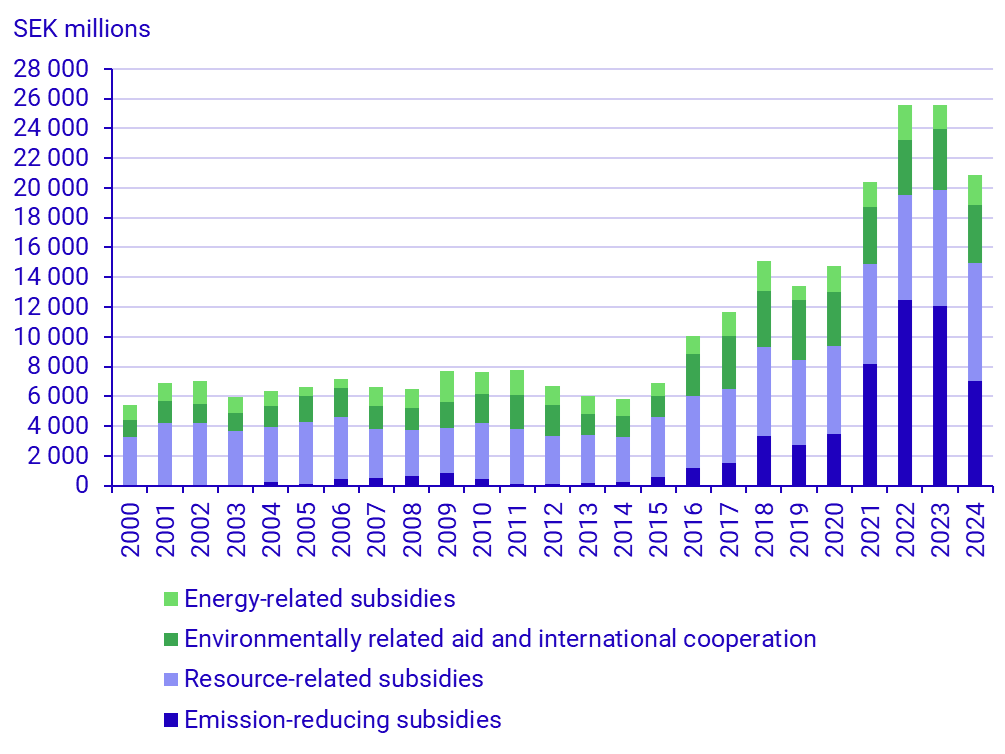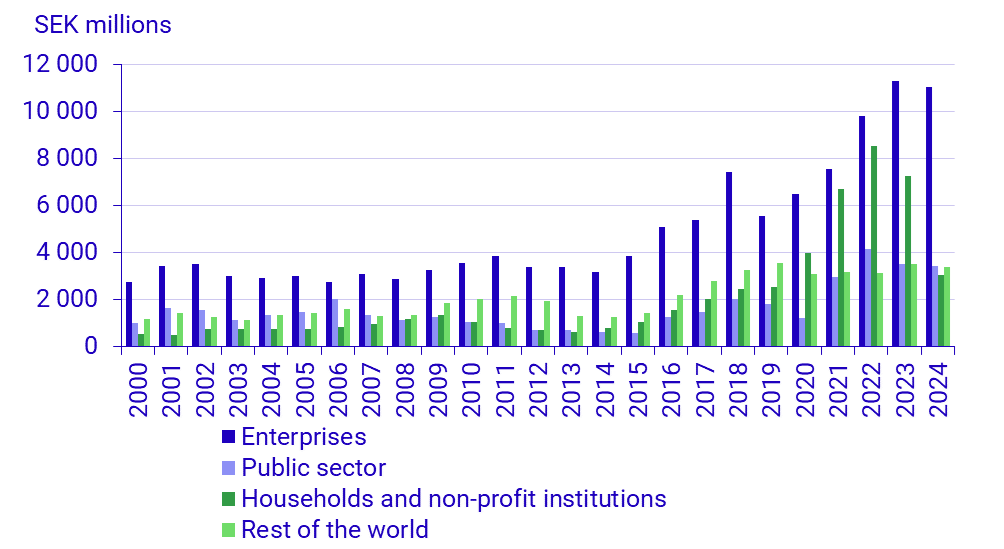Environmentally motivated subsidies 2024
Environmentally motivated subsidies decreased in 2024
Statistical news from Statistics Sweden 2025-06-12 8.00
Environmentally motivated subsidies decreased in 2024 compared to 2023. For 2024 these subsidies amounted to 20.9 billion SEK; an 18 percent decrease from 2023. Environmental subsidies as share of GDP decreased as well, to a share of 0.3 percent of GDP.
Environmentally motivated subsidies, covering transactions contributing to reduced climate and other environmental impacts as well as more efficient natural resource use, was 20.9 billion SEK in 2024. This is a decrease by 4.7 billion SEK compared to 2023. The subsidies cover four areas: emission-reducing subsidies, energy-related subsidies, environmentally related aid and international cooperation, and resource-related subsidies.
- The decrease in 2024 was mainly due to decreased transactions for emission reduction, from 12.1 to 7 billion SEK, says Frida Hellman, analyst at Statistics Sweden. This decrease derives from the bonus for low-emission vehicles subsidies and amounted to 4.5 billion SEK. The bonus for low-emission vehicles has been given for new cars with low impact on the environment since 2019, administered by the Swedish Transport Agency, but is now phased out.

The largest environmental subsidies in emission-reducing subsidies are Supports in the climate area which amounted to 4.2 billion SEK in 2024. This is a decrease from 4.7 billion SEK in 2023. Bonus for low emission vehicles was the previously largest subsidy in this environmental area and amounted to 1.4 billion SEK in 2024 which is a large decrease from 2023. The decrease is explained by the phasing out of the bonus for low-emission vehicles.
The resource-related subsidies where the second largest category, amounting to 8 billion SEK. Environmental improvement measures in agriculture constituted to the largest part of the resource-related subsidies. These include environmental benefits to farmers through the Swedish rural development program, e.g., biodiversity measures in the farmed landscape and environmentally friendly agriculture which are financed by the European Union. More information regarding the subsidy types can be found under tables and graphs.
Environmental subsidies go primarily to companies
The subsidies, that is payments for investment and consumption, can go to different stakeholders nationally and internationally. Swedish companies, non-profit institutions, households, and other public authorities in Sweden where recipients of about 84 percent of the total in 2024. The remainder went to international organisations and aid. Subsidies to domestic stakeholders where 17.5 billion SEK in 2024, a 21 percent decrease compared to 2023. Subsidies to companies decreased by 2 percent in 2024, as compared to 2023.

Revisions
This year environmentally motivated subsidies to forestry have been included for the years 2016-2024, which were previously excluded from the statistics. In addition, environmental aid and international cooperation have been revised upwards for the years 2016–2023 by between 700 million SEK and 1170 million SEK due to improved input data.
In the preparation of the 2024 data, several new environmentally motivated subsidies have been included in the statistics. These include: The National Electrical Safety Board, Charging infrastructure – to the Swedish Energy Agency (STEM) and the Swedish Transport Administration (TRV), EU-funded support measures for fisheries and aquaculture – EHFF 2014–2020, EU-funded measures for rural environmental and structural development – EJLU 2014–2022, EU-funded measures under the Community-Led Local Development program – LLU 2014–2020, and a portion of Energy planning.
In 2023, the Greening Support was removed and replaced with support for Organic Production, Precision Agriculture, and Carbon Sequestration and Reduced Nitrogen Leakage. These supports are presented under the budget item Measures for improving the environment in the agricultural sector.
For more information, see the quality report (available only in Swedish) on Statistics Sweden’s website, here, and under tables and graphs.
Definitions and explanations
Environmentally motivated subsidies are defined in accordance with the SEEA Central Framework statistical standards for environmental accounts. The definition that applies in Statistics Sweden’s environmental accounts is informed by the subsidy objective. Therefore, the definition used in the environmental accounts is broader than the one used in the national accounts, as the environmental accounts also include capital and current transfers and social benefits in kind.
For the environmental accounts, the source for the subsidy objective has been the Government’s Budget Bills for various years. The statistics are derived from the National Financial Management Authority’s calculations of the central government budget’s outcome, in which transactions are traced back to the government appropriations from which they came.
Statistics Sweden has published statistics on environmentally motivated subsidies since 2000.
Next publishing will be
June 2026.
Feel free to use the facts from this statistical news but remember to state Source: Statistics Sweden.
